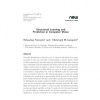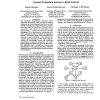AAAI
2012
12 years 9 months ago
2012
We introduce a new task-independent framework to model top-down overt visual attention based on graphical models for probabilistic inference and reasoning. We describe a Dynamic B...
AAAI
2012
12 years 9 months ago
2012
Tractable subsets of first-order logic are a central topic in AI research. Several of these formalisms have been used as the basis for first-order probabilistic languages. Howev...
IUI
2012
ACM
13 years 2 months ago
2012
ACM
Numerous interaction techniques have been developed that make “virtual” pointing at targets in graphical user interfaces easier than analogous physical pointing tasks by invok...
FTCGV
2011
13 years 10 months ago
2011
Powerful statistical models that can be learned efficiently from large amounts of data are currently revolutionizing computer vision. These models possess a rich internal structur...
CVIU
2011
13 years 10 months ago
2011
In this paper, we aim to reconstruct free-form 3D models from only one or few silhouettes by learning the prior knowledge of a specific class of objects. Instead of heuristically...
CHI
2011
ACM
13 years 10 months ago
2011
ACM
We present a finger-tracking system for touch-based interaction which can track 3D finger angle in addition to position, using low-resolution conventional capacitive sensors, th...
AI
2002
Springer
14 years 7 months ago
2002
Springer
Previous experimental results have clearly demonstrated the effectiveness of utilizing context-specific independence (CSI) in probabilistic inference. However, CSI is a special cas...
ECAI
2010
Springer
14 years 8 months ago
2010
Springer
Abstract. There is currently a large interest in relational probabilistic models. While the concept of context-specific independence (CSI) has been well-studied for models such as ...
AAAI
1990
14 years 8 months ago
1990
The Symbolic Probabilistic Inference (SPI) Algorithm [D'Ambrosio, 19891 provides an efficient framework for resolving general queries on a belief network. It applies the conc...
UAI
1998
14 years 8 months ago
1998
There is evidence that the numbers in probabilistic inference don't really matter. This paper considers the idea that we can make a probabilistic model simpler by making fewe...



